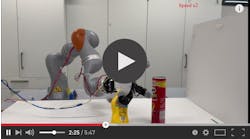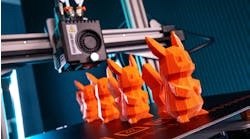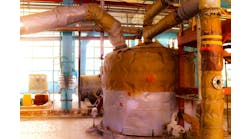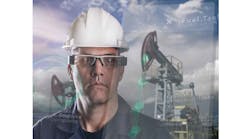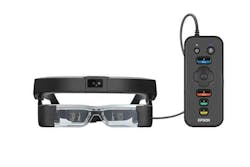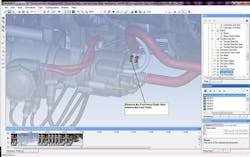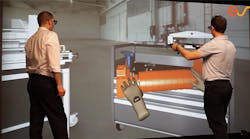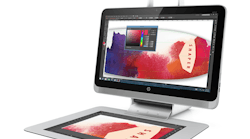The World Wide Web recently turned 25, and in that time, the Internet has become the connective tissue binding every aspect of our lives, from how we shop and entertain ourselves to how and where we work. Now perception itself is poised for a major disruption, as the wearables that augment and virtualize reality transition from fringe gadgetry into indispensable tools.
According to the technology analysis firm, Tractica, the global shipments of enterprise and industrial wearables will soar from 2.3 million last year to 66.4 million units annually by 2021.
That means in five years, nearly 172 million industrial wearables, such as smart glasses and headsets, will be making workers faster, more efficient, and less prone to make careless mistakes.
Photo: Epson
Without a solid operating system and applications, these wearables are just lifeless husks. And the OS and apps you have might not synch with your specific needs, so you probably have to invest in developers and/ or system integrators. You may end up spending thousands outfitting your crew with the hardware, and even more hiring a third party to tailor it for your needs.
“The largest barrier to augmented reality for smart glasses is the cost of content creation, since the cost of creating step-by-step 3D models and AR content is too expensive to be practical for a lot of applications,” says Eric Mizufuka, product manager for Epson, which makes Moverio BT-200 smartglasses ($700) and BT-2000 headset ($3,000). A BT-300 model is coming soon.
Wanting to streamline and democratize the process so wearables aren’t merely a Fortune 500 luxury, the Vancouver-based NGRAIN, a partner of Epson, has upgraded its 3D content creator software, Producer Pro, with the NGRAIN Android Viewer feature. This open source function works out-of-the-box and allows industrial workers to create their own Moverio smartglasses app to engineer, maintain, repair, or visually inspect their equipment and/or processes.
It’s essentially doing for augmented reality what content management systems such as WordPress did for websites.
“It used to be the case, in the early days of web, everything had to be handcrafted using HTML,” says Barry Po, NGRAIN’s senior director of product and business development. “Now you’ve got content management platforms that allow you to create and deploy that content without thinking too much about it. The NGRAIN Android Viewer is very much the same way. It’s software that allows anyone to jump in.”
Mind you, these are industrial “anyones” who will author this content, the ones on the factory floor who know what needs to be optimized and also stand to benefit most.
The biggest benefit this system provides, for whatever process you may have, is the ability to fully operate in a digital space, without the need for bookshelves full of manuals. That simplification and ease of access is a main reason the U.S. military uses NGRAIN software on their ruggedized laptops to field repair Humvees on the battlefield.
Instructions will flash on your Moverio eye piece step-by-step for a maintenance job, and for visual inspection, the checklist pops up right in front of you, with no need to carry around a clip board.
“By spending time with workers using this tech, we’ve learned having digitized checklists become really valuable, because transcribing from a clipboard into the system in some back office chews up a lot of time, and doesn’t add a whole lot value. It only repeats the work done on the line.
Image: NGRAIN
Po says an inspector who designs their checklist via their personally-designed app “does the job once, and doesn’t have to do it again.”
Part of this requires converting equipment CAD files to a format usable on the Viewer, which according to Po, is a “fairly straightforward” process.
And one industrial use case may have found the most intriguing pairing of wearable technology and this software. Po says the company used the 360 deg camera on their BT-2000 to turn the headset into a 3D scanner.
Those scans could then be used to 3D capture the whole plant, and the Viewer could conceivably perform real-time analysis of equipment and automated quality checks. Think of it as an industrial Pokémon GO, where you capture pumps and motors data, as opposed to cartoon creatures. And you can’t make them battle other equipment, but you could detect if it’s due for repair.
“It was a bit unexpected but we are very interested in facilitating more uses like this,” Po says. This function isn’t at this time built into the Viewer but can be made available to NGRAIN customers if they contact them.
In the beginning, the 15-year-old company set out “to make 3D accessible to people who can’t afford the $15,000-30,000 machine required to leverage 3D,” Po says. “Now, with Producer Pro, it’s available to everyone.”
When the Internet was truly democratized, (about the time you realized there were infinitely more interesting things to do online than ask for A/S/L in AOL chatroom), we all realized how big the world was, and how quickly we could traverse it from a swivel chair.
NGRAIN’s open source augmented reality software probably won’t change the world, but it could change your world. By altering the way you perceive and interact with the equipment in your facility, in a way completely decided by you, it could eliminate hours of redundancy and inefficiency, maybe even reducing the number of late nights at the plant, and freeing you up to enjoy the real world.



